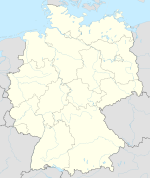Europesaurus
| Europesaurus | ||||||||||||
|---|---|---|---|---|---|---|---|---|---|---|---|---|

Live reconstruction of a young and an adult specimen by E. holgeri . Iguanodontids pass in the background . |
||||||||||||
| Temporal occurrence | ||||||||||||
| Upper Jurassic (middle Kimmeridgian ) | ||||||||||||
| approx. 154.7 million years | ||||||||||||
| Locations | ||||||||||||
|
||||||||||||
| Systematics | ||||||||||||
|
||||||||||||
| Scientific name | ||||||||||||
| Europesaurus | ||||||||||||
| Mateus , Laven & Knötschke , 2006 | ||||||||||||
| Art | ||||||||||||
|
Europesaurus ("Lizard from Europe") is a genus of the sauropod dinosaur and ispart of the original Macronaria within this taxon . The only known species, E. holgeri , was unusually small for a sauropod and lived on one of the Paleo Islands on the southern edge of the Lower Saxony Basin in the Upper Jurassic (middle Kimmeridgium ) of northern Germany.
Find history
Location of the type locality of Europäischeaurus
|
The fossils found so far come from more than eleven individuals of all stages of development ( juvenile , sub- adult or adult) with body lengths between 1.7 and 8 meters from the Langenberg limestone quarry between Oker , a district of Goslar and Göttingerode , a district of Bad Harzburg in Lower Saxony on the northern edge of the Harz Mountains . The marine carbonate rocks found there date from the early Oxfordian to the late Kimmeridgian. The fossil collector Holger Lüdtke discovered the first teeth and bones in 1998; In his honor, the epithet of the type species bears his first name. The scientists, who were informed by Lüdtke in the same year, initially thought the findings were the remains of large juvenile sauropods. They were then prepared in the Münchehagen Dinosaur Park . Along with the fossils of Europasaurus found themselves fish apotosauride crocodiles, pterosaurs , turtles and theropod dinosaurs . The uncovering of the bones is far from over and can be followed in the preparation workshop of the dinosaur park Münchehagen . Since 1999, around 1000 bones from various Europa-saurus individuals have been prepared there. Finds of sauropod skulls are generally rare, the well-preserved cranial bones of EuropaSaurus are the first such fossils found in Europe.
Paleobiology

The sauropods are the largest animals that have ever inhabited the terrestrial (mainland) habitats. Europaaurus shows the opposite development compared to the gigantism typical of sauropods , which is interpreted as an island dwarfing . This is a significant reduction in body size that has recently been observed when islands are colonized by large animals as an evolutionary adaptation to an isolated habitat with limited food supply.
It is assumed that, due to the enormous selection pressure, the unknown ancestor of E. holgeri dwarfed to a maximum of about a ton and 8 meters within a few generations. Camarasaurus , the closest known relative, was three times as long and weighed around 30 tons. It has not yet been clarified whether the ancestor of Europesaurus was isolated on the island, which was shrinking due to the rising sea level ( marine transgression ), or whether it immigrated later and then reduced its size.
Long bones histology
The determination of the relative individual age was possible with the help of the histology of the long bones at the University of Bonn . The bone microstructure shows that Europasaurus unlike the Großsauropoden very slowly grew. Investigations on thin-section specimens of the bone cross-section reveal standstill marks in the bone, which indicate growth interruptions. In the cortical bone (cortical bone) of the major bones are found closely related arrest marks that prove that she had already ended at the time of death growth. This proves that the largest individuals found are adult specimens that have already reached their final size.
literature
- P. Martin Sander , Octávio Mateus, Thomas Laven, Nils Knötschke: Bone histology indicates insular dwarfism in a new Late Jurassic sauropod dinosaur. In: Nature . Vol. 441, No. 7094, 2006, pp. 739–741, doi : 10.1038 / nature04633 , digitized version (PDF; 264.58 kB) ( Memento from July 7, 2006 in the Internet Archive ).
Web links
- Press information from the University of Bonn
- Bone histology indicates insular dwarfism in a new Late Jurassic sauropod dinosaur short version (abstract) by P. Martin Sander (2006) (engl.)
- Additional information on the Nature article Word file
- Additional information on the Nature article images and descriptions
- Jurassic Harz Further information from Nils Knötschke
Individual evidence
- ^ Gregory S. Paul : The Princeton Field Guide To Dinosaurs. Princeton University Press, Princeton NJ et al. 2010, ISBN 978-0-691-13720-9 , p. 200, online .





